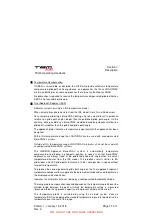
Pilot's Operating Handbook
Section 7
Description
Edition 1 - January 15, 2018
Rev. 0
Page 7.14.2
Static dischargers
As an aid in flight, static dischargers are installed to improve radio communications
during flight by reducing interference from dust or various forms of precipitations (rain,
snow or ice crystals).
Under these conditions, the build-up and discharge of static electricity from the trailing
edges of the wings (flaps and ailerons), rudder, stabilator, propeller tips and radio
antennas can result in loss of usable radio signals on all communications and
navigation radio equipment. Usually, the ADF is first and VHF communication
equipment is the last to be affected.
Installation of static dischargers reduces interference from precipitation static, but it is
possible to encounter severe precipitation static conditions which might cause the
loss of radio signals, even with static dischargers installed. Whenever possible, avoid
known severe precipitation areas to prevent loss of dependable radio signals. If
avoidance is impractical, minimize airspeed and anticipate temporary loss of radio
signals while in these areas.
Cabin fire extinguisher
The fire extinguisher is located on R.H. front station side panel.
A pressure gage allows checking the fire extinguisher condition. Follow the
recommendations indicated on the extinguisher.
Autopilot
Autopilot control panel is located above the MFD. Refer to section 2 Limitations of this
POH and to GARMIN Pilot's Guide for further details.
GPS
GPS navigation is performed through the GARMIN system. Refer to section 2
Limitations and section 4 Normal procedures of this POH and to GARMIN Pilot's
Guide for further details.
PIM - DO NOT USE FOR FLIGHT OPERATIONS















































